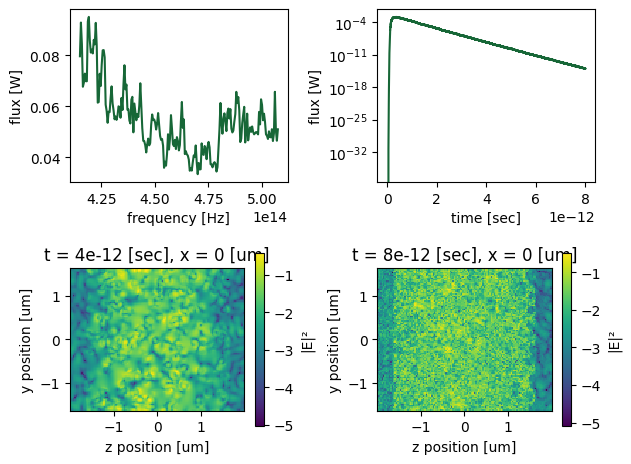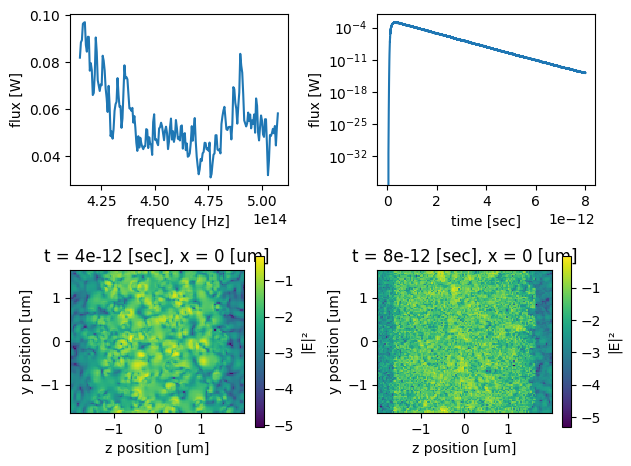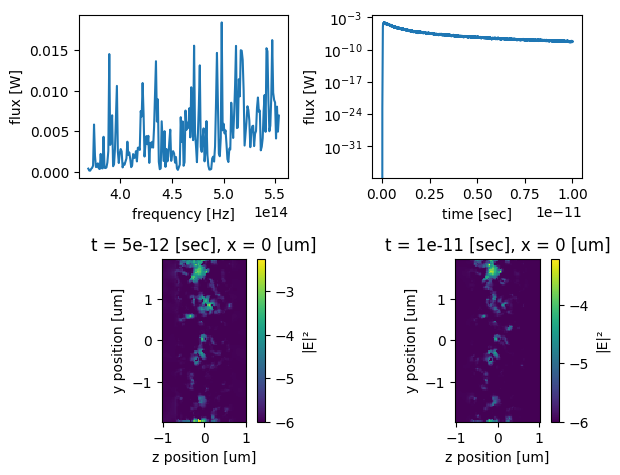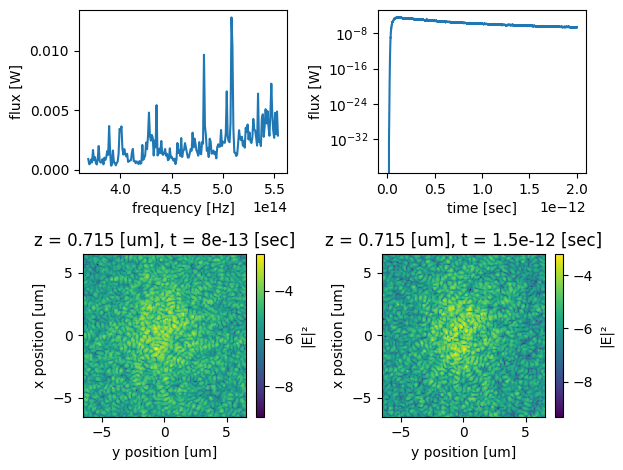Anderson localization of electromagnetic waves in 3D#
Anderson localization (AL) is an effect that is characterized by a halt of diffusive wave propagation. Despite extensive studies over the past 40 years, AL of the electromagnetic waves in three dimensions has remained elusive, leading to the question of its very existence.
This notebook investigates the presence of AL in aggregates formed by a random placement of spheres made of either dielectric or perfect electric conductor (PEC). We use Tidy3D to simulate transmission of light through the aggregate arranged in the shape of a slab. From these simulations, we are able to identify for the first time, the hallmarks of Anderson localization in the PEC aggregate.
We study three specific case studies here:
The time and frequency dependence of transmission of light through a slab of randomly distributed dielectric spheres.
The time and frequency dependence of transmission of light through a slab of perfectly conducting (PEC) spheres.
The spatio-temporal dynamics of a beam being transmitted through this same slab.
These and related simulations were used to produce the results of our paper “Anderson localization of electromagnetic waves in three dimensions” by Yamilov, et al. For more details we refer the reader to this paper or its pre-preprint version, available here.
If you are new to the finite-difference time-domain (FDTD) method, we highly recommend going through our FDTD101 tutorials.
For more interesting contents in the realm of nanophotonics, please check out the case studies on hyperbolic polaritons, non-Hermitian metagratings, and plasmonic nanoantennas.
[1]:
%load_ext autoreload
%autoreload 2
%matplotlib inline
from dataclasses import dataclass
from typing import List, Tuple
import matplotlib.pyplot as plt
import numpy as np
import scipy.io as sio
import tidy3d as td
from tidy3d import web
td.config.logging.level = "ERROR"
Define our case study parameters#
We now define some global parameters of the simulation, a datastructure to store our case study input parameters, and 3 specific instances of these parameters, which we will run at the end.
[2]:
# parameters that are constant for all the simulations
wavelength = 0.65
freq0 = td.C_0 / wavelength
grids_pw = 20
npml = 2 * grids_pw
random_seed = 1
# Define grid spec
dl = wavelength / grids_pw
grid_spec = td.GridSpec.uniform(dl=dl)
# Define PML layers, for this we have no PML in x, y but `npml` cells in z
periodic_bc = td.Boundary(plus=td.Periodic(), minus=td.Periodic())
pml = td.Boundary(plus=td.Absorber(num_layers=npml), minus=td.Absorber(num_layers=npml))
boundary_spec = td.BoundarySpec(x=periodic_bc, y=periodic_bc, z=pml)
[3]:
@dataclass
class SimulationParameters:
"""Stores parameters for a given simulation."""
f0a: List[float] # Array of frequencies to scan via FFT (in units of freq0)
Lx: float # Length of slab in x
Ly: float # Length of slab in y
Lz: float # Length of slab in z
space: float # Space between PML and slab
fwidth: float # Bandwidth of the excitation pulse in Hz
offset: float # Gaussian source offset; the source peak is at time t = offset/fwidth
run_time: float # Run time of simulation (sec)
ff0: float # Nominal volume filling fraction, actual filling fraction is lower due to overlap between spheres
radius: float # Radius of spheres (um)
material: str # type of material to use for spheres. "dielectric" or "PEC"
subpixel: td.SubpixelSpec # subpixel smoothening spec to be used
sim_mode: str # Mode of simulation ("transmission" or "beam_spreading")
task_name: str # Name of the task in tidy3d
ref_ind: float = None # Refractive index of the spheres, needed if material == 'dielectric'
Nt: int = 1 # Number of snapshots in the field time dependence monitor
[4]:
# 1. Transmittance simulation (dielectric spheres)
sim_params_1 = SimulationParameters(
Lx=5 * wavelength,
Ly=5 * wavelength,
Lz=5 * wavelength,
space=2 * wavelength,
radius=0.1,
ff0=0.35,
fwidth=freq0 / 20.0,
offset=10.0,
run_time=8e-12,
f0a=np.linspace(0.9, 1.1, 201).tolist(),
material="dielectric",
ref_ind=3.5,
subpixel=td.SubpixelSpec(),
sim_mode="transmission",
task_name="dielectric_transmission",
)
[5]:
# 2. Transmittance simulation (PEC spheres)
sim_params_2 = SimulationParameters(
Lx=6 * wavelength,
Ly=6 * wavelength,
Lz=2 * wavelength,
space=2 * wavelength,
radius=0.05,
ff0=0.80,
fwidth=freq0 / 7.0,
offset=10.0,
run_time=10e-12,
f0a=np.linspace(0.8, 1.2, 201).tolist(),
material="PEC",
ref_ind=None,
subpixel=td.SubpixelSpec(),
sim_mode="transmission",
task_name="PEC_transmission",
)
[6]:
# 3. Transverse spreading simulation (PEC spheres)
sim_params_3 = SimulationParameters(
Lx=20 * wavelength,
Ly=20 * wavelength,
Lz=2 * wavelength,
space=2 * wavelength,
radius=0.05,
ff0=0.80,
fwidth=freq0 / 7.0,
offset=10.0,
run_time=2e-12,
Nt=2,
f0a=np.linspace(0.8, 1.2, 201).tolist(),
material="PEC",
ref_ind=None,
subpixel=td.SubpixelSpec(),
sim_mode="beam_spreading",
task_name="PEC_beam_spreading",
)
Construct Simulation#
Next, we write a few functions to generate a simulation based on our input parameters.
[7]:
def get_mediums(sim_params: SimulationParameters) -> Tuple[td.Medium, td.Medium]:
"""Get the mediums corresponding to the spheres and the background, respectively."""
if sim_params.material == "dielectric":
if sim_params.ref_ind is None:
raise ValueError("must specify SimulationParameters.ref_ind")
ff_appx = 1 - np.exp(-sim_params.ff0)
medium_spheres = td.Medium(permittivity=sim_params.ref_ind**2)
medium_out = td.Medium(permittivity=1 + (sim_params.ref_ind**2 - 1) * ff_appx)
elif sim_params.material == "PEC":
medium_spheres = td.PEC
medium_out = td.Medium(permittivity=1)
else:
raise ValueError(f"unrecognized 'material' of {sim_params.material}")
return medium_spheres, medium_out
[8]:
# properties derived from sim_parameters
def make_sim(sim_params: SimulationParameters) -> td.Simulation:
"""Generate a simulation from given parameters."""
medium_spheres, medium_out = get_mediums(sim_params)
Lx = sim_params.Lx
Ly = sim_params.Ly
Lz = sim_params.Lz
radius = sim_params.radius
space = sim_params.space
run_time = sim_params.run_time
Lz_tot = 2 * space + Lz
sim_size = [Lx, Ly, Lz_tot]
# number of spheres to place = slab volume * nominal_density
expanded_volume = (Lx + 2 * radius) * (Ly + 2 * radius) * (Lz + 2 * radius)
nominal_density = sim_params.ff0 / (4 * np.pi / 3 * radius**3)
num_spheres = int(expanded_volume * nominal_density)
# Randomly position spheres
np.random.seed(random_seed)
sphere_geometries = []
print(f"inserting {num_spheres:2e} spheres")
for i in range(num_spheres):
position_x = np.random.uniform(-Lx / 2 - radius, Lx / 2 + radius)
position_y = np.random.uniform(-Ly / 2 - radius, Ly / 2 + radius)
position_z = np.random.uniform(-Lz / 2 - radius, Lz / 2 + radius)
sphere_i = td.Sphere(center=[position_x, position_y, position_z], radius=radius)
sphere_geometries.append(sphere_i)
spheres = td.Structure(
geometry=td.GeometryGroup(geometries=sphere_geometries), medium=medium_spheres
)
# Define effective medium around the slab
box_in = td.Box(center=[0, 0, -Lz / 2 - space], size=[td.inf, td.inf, 2 * space])
box_out = td.Box(center=[0, 0, Lz / 2 + space], size=[td.inf, td.inf, 2 * space])
struct_in = td.Structure(geometry=box_in, medium=medium_out)
struct_out = td.Structure(geometry=box_out, medium=medium_out)
structures = [spheres, struct_in, struct_out]
# Define incident plane wave
gaussian = td.GaussianPulse(
freq0=freq0, fwidth=sim_params.fwidth, offset=sim_params.offset, phase=0
)
if sim_params.sim_mode == "transmission":
source_size = (td.inf, td.inf, 0)
elif sim_params.sim_mode == "beam_spreading":
source_size = (0.25, 0.25, 0.0)
else:
raise ValueError(f"sim_mode of {sim_params.sim_mode} not recognized.")
# angle of polarization w.r.t. to the x axis (x-polarized)
source = td.PlaneWave(
size=source_size,
center=(0, 0, -Lz_tot / 2.0 + 0.1),
source_time=gaussian,
direction="+",
pol_angle=0,
)
freqs_fft = (freq0 * np.array(sim_params.f0a)).tolist()
# Records CW (via FFT) transmitted flux through the slab
freq_monitorT = td.FluxMonitor(
center=[0.0, 0.0, Lz / 2.0 + space / 2.0],
size=[td.inf, td.inf, 0],
freqs=freqs_fft,
name="freq_monitorT",
)
# Records time-dependent transmitted flux through the slab
time_monitorT = td.FluxTimeMonitor(
center=[0.0, 0.0, Lz / 2.0 + space / 2.0],
size=[td.inf, td.inf, 0],
name="time_monitorT",
)
# Records E-fields throughout simulation volume at t=run_time/2
time_monitorZH = td.FieldTimeMonitor(
center=[0.0, 0.0, 0.0],
size=[td.inf, td.inf, Lz + wavelength],
start=run_time / 2.0,
stop=run_time / 2.0,
fields=["Ex", "Ey", "Ez"],
name="time_monitorZH",
)
# Records E-fields throughout simulation volume at t=run_time
time_monitorZ = td.FieldTimeMonitor(
center=[0.0, 0.0, 0.0],
size=[td.inf, td.inf, Lz + wavelength],
start=run_time,
stop=run_time,
fields=["Ex", "Ey", "Ez"],
name="time_monitorZ",
)
N_run_time = int(sim_params.run_time / (0.99 * wavelength / (grids_pw * td.C_0 * np.sqrt(3))))
# Records E-fields at the output surface at Nt equally spaced times from 0 to run_time
spread_monitor = td.FieldTimeMonitor(
center=[0.0, 0.0, Lz / 2.0 + 2 * wavelength / grids_pw],
size=[td.inf, td.inf, 0.0],
start=0.4 * run_time,
stop=0.9 * run_time,
interval=int(N_run_time / sim_params.Nt),
fields=["Ex", "Ey", "Ez"],
name="spread_monitor",
)
# Records permittivity throughout simulation volume
eps_monitor = td.PermittivityMonitor(
center=[0.0, 0.0, 0.0],
size=[td.inf, td.inf, Lz + wavelength],
freqs=[freq0],
name="eps_monitor",
)
monitors = [freq_monitorT, time_monitorT, eps_monitor]
if sim_params.sim_mode == "transmission":
monitors.append(time_monitorZH)
monitors.append(time_monitorZ)
elif sim_params.sim_mode == "beam_spreading":
monitors.append(spread_monitor)
else:
raise ValueError(f"sim_mode of {sim_params.sim_mode} not recognized.")
# Define simulation parameters
sim = td.Simulation(
size=sim_size,
grid_spec=grid_spec,
structures=structures,
sources=[source],
monitors=monitors,
run_time=run_time,
boundary_spec=boundary_spec,
shutoff=1e-15,
subpixel=sim_params.subpixel,
)
return sim
Post process data#
Next, we write some functions to process the simulation data from tidy3d into a datastructure storing the output quantities of interest.
[9]:
@dataclass
class SimulationOutputs:
"""Stores outputs of a given simulation."""
flux_f: td.FluxDataArray # Flux transmission as a function of frequency
flux_t: td.FluxTimeDataArray # Flux transmission as a function of time
eps: td.ScalarFieldDataArray # Relative permittivity at the Ex positions in the yee lattice
ff_realized: float # Sphere filling fraction as computed from the raw permittivity distribution
int_half: td.ScalarFieldTimeDataArray = (
None # Field intensity at the time halfway through simulation
)
int_end: td.ScalarFieldTimeDataArray = None # Field intensity at the final time in simulation
int_spread: td.ScalarFieldTimeDataArray = (
None # Fiend intensity cross section as function of time
)
[10]:
def compute_ff(sim_params: SimulationParameters, eps: td.ScalarFieldDataArray) -> float:
"""Compute effective filling fraction from data."""
Lz = sim_params.Lz
eps_in_slab = np.real(eps)
eps_in_slab = eps_in_slab.where(eps_in_slab.z < Lz / 2, drop=True)
eps_in_slab = eps_in_slab.where(eps_in_slab.z > -Lz / 2, drop=True)
if sim_params.material == "dielectric":
eps_max = sim_params.ref_ind**2
ff = (np.mean(eps_in_slab.values) - 1) / (eps_max - 1)
elif sim_params.material == "PEC":
is_material = 1.0 * (eps_in_slab.values != 1.0)
ff = np.mean(is_material)
else:
raise ValueError(f"unrecognized 'material' of {sim_params.material}")
return ff
[11]:
def post_process_results(
sim_params: SimulationParameters, sim_data: td.SimulationData
) -> SimulationOutputs:
"""Process the results of a simulation run into SimulationOutputs."""
eps = sim_data["eps_monitor"].eps_xx
ff_realized = compute_ff(sim_params, eps)
if sim_params.sim_mode == "transmission":
sim_outputs = SimulationOutputs(
flux_f=sim_data["freq_monitorT"].flux,
flux_t=sim_data["time_monitorT"].flux,
int_half=sim_data.get_intensity("time_monitorZH"),
int_end=sim_data.get_intensity("time_monitorZ"),
eps=sim_data["eps_monitor"].eps_xx,
ff_realized=ff_realized,
)
elif sim_params.sim_mode == "beam_spreading":
int_spread = sim_data.get_intensity("spread_monitor")
sim_outputs = SimulationOutputs(
flux_f=sim_data["freq_monitorT"].flux,
flux_t=sim_data["time_monitorT"].flux,
eps=sim_data["eps_monitor"].eps_xx,
ff_realized=ff_realized,
int_spread=int_spread,
)
else:
raise ValueError(f"sim_mode of {sim_params.sim_mode} not recognized.")
return sim_outputs
Run FDTD simulation#
Next, we write a function to compute our simulation outputs given simulation parameters through a tidy3d simulation.
[12]:
def run(sim_params: SimulationParameters) -> SimulationOutputs:
"""process simulation parameters into simulation outputs through a tidy3d simulation."""
sim = make_sim(sim_params)
sim_data = web.run(sim, task_name=sim_params.task_name)
return post_process_results(sim_params, sim_data)
Visualization#
Next, we write a function to visualize the simulation outputs depending on the data contained within.
[13]:
def plot_transmission(sim_params: SimulationParameters, sim_outputs: SimulationOutputs) -> None:
f, ((ax1, ax2), (ax3, ax4)) = plt.subplots(2, 2, tight_layout=True)
sim_outputs.flux_f.plot(ax=ax1)
sim_outputs.flux_t.plot(ax=ax2)
def take_log(intensity):
return np.log10(intensity / intensity.max() + 1e-6)
if sim_outputs.int_half is not None:
# Intensity section I(0,y,z;tmax/2)
take_log(sim_outputs.int_half).interp(x=0).squeeze().plot.pcolormesh(ax=ax3)
take_log(sim_outputs.int_end).interp(x=0).squeeze().plot.pcolormesh(ax=ax4)
ax2.set_yscale("log")
ax3.set_aspect(1)
ax4.set_aspect(1)
elif sim_outputs.int_spread is not None:
# Intensity section I(x,y,L;t)
np.log10(sim_outputs.int_spread).isel(t=0).squeeze().plot.pcolormesh(ax=ax3)
np.log10(sim_outputs.int_spread).isel(t=-1).squeeze().plot.pcolormesh(ax=ax4)
ax2.set_yscale("log")
ax3.set_aspect(1)
ax4.set_aspect(1)
plt.show()
Combined Workflow#
Finally, we’ll combine all the previous steps into a single function to process and visualize a set of simulation parameters.
[14]:
def workflow(sim_params: SimulationParameters) -> SimulationOutputs:
"""Run the simulation, plot results, and compute fill fraction."""
# run the simulation
sim_outputs = run(sim_params)
# display the fill fraction
print(f"ff_realized = {(sim_outputs.ff_realized * 100):.2f} %")
# plot data
plot_transmission(sim_params, sim_outputs)
# plot the simulation
sim = make_sim(sim_params)
f, (ax1, ax2) = plt.subplots(1, 2, tight_layout=True)
sim.plot(x=0, monitor_alpha=0, ax=ax1)
sim.plot(z=0, monitor_alpha=0, ax=ax2)
plt.show()
return sim_outputs
Case Studies#
Now we are ready to put everything together to run our three case studies.
Dielectric Sphere Transmission#
First, we simulate a pulse transmission through a slab containing randomly distributed dielectric spheres. It shows that transmitted flux decays mono-exponentially with time, as expected for diffusive transport. y-z cross-sections of the spatial intensity distribution, obtained at long times show sine-like dependence with the depth coordinate z, also expected in diffusion. We also show y-z and x-y slices of dielectric permeability of the simulated system for illustration.
[15]:
sim_outputs_1 = workflow(sim_params_1)
inserting 3.431000e+03 spheres
19:02:10 CEST Created task 'dielectric_transmission' with task_id 'fdve-e7a8f2d6-c68b-4425-8b1d-6a75024350ff' and task_type 'FDTD'.
View task using web UI at 'https://tidy3d.simulation.cloud/workbench?taskId=fdve-e7a8f2d6-c6 8b-4425-8b1d-6a75024350ff'.
Task folder: 'default'.
19:02:13 CEST Maximum FlexCredit cost: 0.119. Minimum cost depends on task execution details. Use 'web.real_cost(task_id)' to get the billed FlexCredit cost after a simulation run.
19:02:14 CEST status = queued
To cancel the simulation, use 'web.abort(task_id)' or 'web.delete(task_id)' or abort/delete the task in the web UI. Terminating the Python script will not stop the job running on the cloud.
19:02:37 CEST starting up solver
running solver
19:03:32 CEST status = postprocess
19:03:34 CEST status = success
19:03:36 CEST View simulation result at 'https://tidy3d.simulation.cloud/workbench?taskId=fdve-e7a8f2d6-c6 8b-4425-8b1d-6a75024350ff'.
19:03:40 CEST loading simulation from simulation_data.hdf5
ff_realized = 27.56 %

inserting 3.431000e+03 spheres

PEC Transmission#
Next we simulate a pulse transmission through a slab containing randomly distributed PEC spheres. It shows that transmitted flux decays non-exponentially with time, as predicted for AL. y-z cross-sections of the spatial intensity distribution, obtained at long times show confined (i.e. localized) states. We also show y-z and x-y slices of dielectric permeability of the simulated system for illustration.
[16]:
sim_outputs_2 = workflow(sim_params_2)
inserting 3.422400e+04 spheres
19:03:43 CEST Created task 'PEC_transmission' with task_id 'fdve-61b085a4-6f3f-48cb-9d7b-eb3ebae430e4' and task_type 'FDTD'.
View task using web UI at 'https://tidy3d.simulation.cloud/workbench?taskId=fdve-61b085a4-6f 3f-48cb-9d7b-eb3ebae430e4'.
Task folder: 'default'.
19:03:54 CEST Maximum FlexCredit cost: 0.242. Minimum cost depends on task execution details. Use 'web.real_cost(task_id)' to get the billed FlexCredit cost after a simulation run.
19:03:55 CEST status = queued
To cancel the simulation, use 'web.abort(task_id)' or 'web.delete(task_id)' or abort/delete the task in the web UI. Terminating the Python script will not stop the job running on the cloud.
19:11:19 CEST status = preprocess
19:11:25 CEST starting up solver
19:11:26 CEST running solver
19:13:11 CEST status = postprocess
19:13:20 CEST status = success
19:13:22 CEST View simulation result at 'https://tidy3d.simulation.cloud/workbench?taskId=fdve-61b085a4-6f 3f-48cb-9d7b-eb3ebae430e4'.
19:13:26 CEST loading simulation from simulation_data.hdf5
ff_realized = 68.52 %

inserting 3.422400e+04 spheres

PEC Beam Spreading#
Finally, we simulate transverse beam spreading at the output surface of a slab containing PEC spheres. It shows that transmittance flux decays mono-exponentially with time, as expected for diffusive transport. Spatial x-y intensity distributions at the output surface, obtained at long times show that the beam waist does not increase with time. We also show y-z and x-y slices of dielectric permeability of the simulated system for illustration.
[17]:
sim_outputs_3 = workflow(sim_params_3)
inserting 3.670810e+05 spheres
19:13:51 CEST Created task 'PEC_beam_spreading' with task_id 'fdve-673ee63d-4139-4244-92b9-b76b1bd57ee9' and task_type 'FDTD'.
View task using web UI at 'https://tidy3d.simulation.cloud/workbench?taskId=fdve-673ee63d-41 39-4244-92b9-b76b1bd57ee9'.
Task folder: 'default'.
19:15:29 CEST Maximum FlexCredit cost: 0.536. Minimum cost depends on task execution details. Use 'web.real_cost(task_id)' to get the billed FlexCredit cost after a simulation run.
19:15:50 CEST status = queued
To cancel the simulation, use 'web.abort(task_id)' or 'web.delete(task_id)' or abort/delete the task in the web UI. Terminating the Python script will not stop the job running on the cloud.
19:17:21 CEST status = preprocess
19:18:05 CEST starting up solver
19:18:06 CEST running solver
19:19:17 CEST status = postprocess
19:20:08 CEST status = success
19:20:10 CEST View simulation result at 'https://tidy3d.simulation.cloud/workbench?taskId=fdve-673ee63d-41 39-4244-92b9-b76b1bd57ee9'.
19:20:14 CEST loading simulation from simulation_data.hdf5
ff_realized = 68.46 %

inserting 3.670810e+05 spheres
